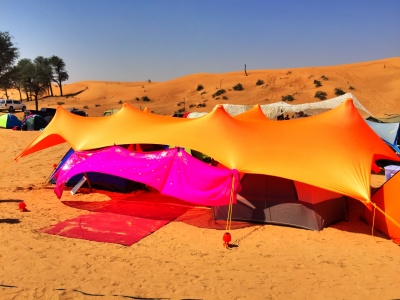Difference between revisions of "Low Shade"
m |
|||
| Line 2: | Line 2: | ||
[[File:The.eye.shade.BT17.1.jpg|400px]] [[File:The.eye.shade.BT17.2.jpg|400px]] [[File:The.eye.shade.BT17.3.jpg|310px]] [[File:The.eye.shade.BT17.4.jpg|174px]] [[File:The.eye.shade.BT17.5.jpg|310px]]<BR> | [[File:The.eye.shade.BT17.1.jpg|400px]] [[File:The.eye.shade.BT17.2.jpg|400px]] [[File:The.eye.shade.BT17.3.jpg|310px]] [[File:The.eye.shade.BT17.4.jpg|174px]] [[File:The.eye.shade.BT17.5.jpg|310px]]<BR> | ||
The Eye's Low Shade at Bedouin Tech 2017 | The Eye's Low Shade at Disorient Bedouin Tech, Dubai 2017<BR> | ||
Lowroad's description from Summer 2009:<BR> | Lowroad's description from Summer 2009:<BR> | ||
Revision as of 05:17, 13 March 2018
by Lowroad, Jan and friends.





The Eye's Low Shade at Disorient Bedouin Tech, Dubai 2017
Lowroad's description from Summer 2009:
"The shade structures we have made in the past utilize stretch material such as spandex as a tensioning membrane that is essentially tethered to the ground at the four corners or the perimeter edges. Then simple 1" conduit (8-12') poles are pushed up from the bottom side and held into place by the tension. We cap the poles with tennis balls (slit balls placed over the pipe and then duct taped into place).
The bottom of the pole is slid overtop of a 24" piece of rebar pounded 12" into the playa. When the wind blows the fabric at times lofts into the air, the pole stays in place with the help of the rebar and the fabric comes back down to rest on the tennis balls again. In this way these structures work in concordance with the wind instead of working against it.
1" conduit is used as it is the smallest diameter rebar that easily fits over a piece of rebar. Long 12' or 10' are the best to buy. They can be cut on playa if they are too tall. 10' seems ideal for the tallest members because much head room is lost in the slope from the peak down to the outside edges. In the past the # of prop up poles used for each structure varies wildly- much depends on the given space one is trying to cover, the size and relative stretch of the material and the obstacles that one is working around. We always start with a good plan, but improvisation is what helps us land.
Be prepared with twice as much rope as you think you need. And bring 1 golf ball or other small solid object for every point at which you want to tie the rope to the material. It will be very helpful. I always forget to bring this and I curse myself."

